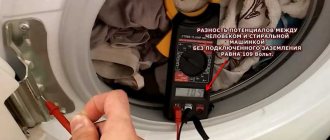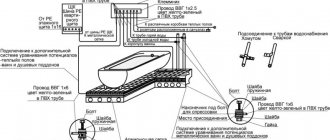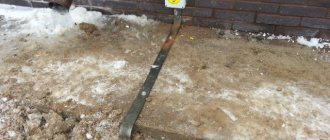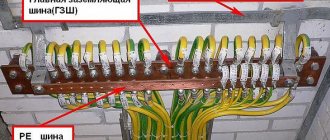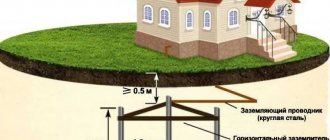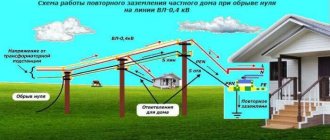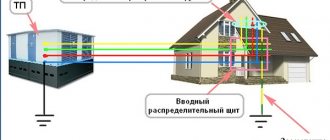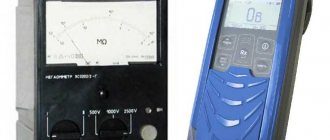To obtain hot water at home, many private home owners install boilers or instantaneous heaters. However, users often forget or are not aware that the operation of such devices involves the risk of electric shock - through contact with the housing, plumbing equipment, or even water flow. Therefore, we will look at how to ground a water heater in your home, what grounding is and why it is needed, in what ways it is not permissible to do it, and which are better to use.
Safe operation of a boiler in a private home requires proper grounding Source ytimg.com
Grounding - what is it, why is it needed?
The operation of an electric water heater comes down to contact of a certain volume or flow of water with a heating element or coil. The heating element includes a special metal spiral with high resistance. When current passes through it, heat is released, which is transferred through surface contact to the water. As a result, the user receives hot water at the outlet of the tap.
The very specific nature of the operation of such a device does not exclude phase breakdown into the body and water mass. Therefore, on its outer part there is a special separate mount for the grounding conductor. The latter is connected to a grounding loop located outside the building and buried in the ground. In the event of a breakdown, the current will not flow to the housing, through pipes and water, but will safely go into the ground.
From the point of view of the requirements of electrical installation work, the need to ground a flow-type or storage water heater in a private house is determined by the following number of factors:
- Damage to the electrical insulation of the heating element due to corrosion or overheating due to a malfunction of the automation.
- Short circuit and phase breakdown to the housing.
See also: Catalog of companies that specialize in electrical work of any complexity
- The occurrence of stray currents on metal parts of an electrical appliance.
- Static electricity builds up as a result of water flow.
- Attracting a lightning strike in a thunderstorm.
All these factors, during contact with the boiler body, faucet, plumbing fixture, or even water flow, lead to the formation of an electrical “heater-man-ground” circuit. As a result, depending on the situation, you can get an electric shock to varying degrees.
Note! Without proper grounding, both instantaneous and storage water heaters cannot operate efficiently and safely. For example, disconnecting the boiler from the network while taking a shower leads to a failure in the settings, as a result of which the device will overuse electricity. In addition, connection to the ground is one of the mandatory conditions of the installation regulations.
Reliable grounding can only be achieved by a properly designed metal circuit Source pinimg.com
Why do you need a water heater in your dacha?
A water heater in a country house can have many meanings: with its help you can not only take a shower, but also wash dishes, do laundry, and do cleaning. However, no matter what purpose you need hot water for, today its uninterrupted availability in a country house is no longer a luxury, but a completely ordinary convenience.
To provide yourself with the most comfortable conditions for relaxation in this regard, an electric water heater is the best choice. They can be either different in their location, such as Ariston - horizontal type water heaters, or vertical - like Gorenije. (See also: How to connect a water heater)
Electric water heaters are the most optimal devices for providing a summer house or country house with hot water: electricity is available in every cottage village, this benefit of civilization does not need to be stored for future use, such as firewood or buying cylinders (gas), and with the help of electricity, the water heats up quickly enough. In addition, the heating process does not require additional human control.
Electric water heaters are:
- storage (water is accumulated in a separate tank and heated there. One of these is Baxi electric water heaters);
- flow-through (water accumulates and is heated inside the tank using a heating element. The greater the water pressure, the cooler it will become);
- bulk (water is poured into the jar manually, unlike the first two types, after which you will have to wait for some time until it heats up to the required temperature).
The latter type of water heaters has become quite rare in stores recently, but many still continue to use them, since few people still have a centralized water supply in towns and villages.
To choose the right electric water heater for a summer house or country house, you should consider how it will be used most, how many people will use it and at what time of year, as well as how much you are willing to spend on it.
Its location, future dimensions, volume, connection method, power and many other characteristics will depend on all this. Clage water heaters are the most compact, they are designed for a small family and have small dimensions. Of the larger ones, it is worth noting StiebelEltron and Superlux.
Unacceptable grounding methods
Owners of private houses often violate the requirements for the safe connection of electric heating equipment by using the following unacceptable methods for grounding:
- Connecting the ground conductor to the water supply or heating riser. Even if the pipeline comes into contact with the ground at some point in its trajectory, this method does not guarantee complete grounding. In addition, through pipes and heating appliances, the phase can easily affect any person who touches the water or appliance anywhere in the house.
- Transferring the grounding wire to the elements of fastening the housing to the wall. The bracket attached to the wall is not connected to the ground at all. Therefore, the problem cannot be solved this way.
- Combining “zero” and “ground” in a socket. This is a rather dangerous method of grounding a boiler - since in the event of a break in the zero supply or switching in the electrical panel, a phase transfer will occur to the housings of all devices connected to the network.
Each grounded device must have its own contact on the bus Source biysk-tv.ru
- Serial grounding of several devices. If at least one of the circuit participants fails, all connected equipment will be under dangerous voltage.
- Simultaneous connection of several wires to one terminal. Each grounded device must have an individual contact.
Advice! An alternative way that allows you to connect and safely operate an instantaneous or storage water heater without grounding is to install an RCD in the circuit - a residual current device, also called a differential circuit breaker. In the event of a phase breakdown, it will immediately turn off the voltage supply.
Electrical wiring diagram of an apartment building
Until 1998, according to the standards in force at that time, most houses were powered using the so-called TN-C circuit or a circuit with a solidly grounded neutral.
A four-core cable was installed in the house, which had 3 phases and one neutral conductor. In an apartment, such a system is easy to identify - all sockets do not have a protective contact, they are two-pin.
In modern houses, the power supply is supplied by a five-core cable (TN-S wiring), in which the working and protective neutral wires are separated. The sockets have a protective contact, just like when using the TN-CS circuit. There are other grounding schemes.
Grounding organization diagrams
“The figure shows possible options for power supply and grounding schemes. If you don’t have exact information about what kind of circuit is organized in your home, contact the energy specialist of the management company.”
Briefly about the main thing
Grounding is a separate electrical conductor leading from the device body to the grounding office. In the event of a breakdown, the current will immediately go into the ground without harming the residents of the house. The need for grounding for water heating equipment is due to the following factors:
- Destruction of heating element insulation.
- Phase breakdown on the body.
- Stray currents.
- Static electricity.
- Lightning strike.
In order to ground a water heater or boiler both in a country house and in a private house, it is necessary to install a special metal circuit in the ground at some distance from the foundation. It is unacceptable to ground in the following ways - by transferring the “ground” conductor to a pipeline or fastening, combining the “zero” with the “ground” in the socket, connecting several devices in series, connecting the conductors from different devices to one terminal.
Contour collection
We cut the corner into six strips of three meters each. We cut one side of three of them at an acute angle with a grinder; in the future it will be much easier to drive them into the ground. We dig a triangular ditch in the ground, with a side length of a little more than three meters and a depth of 30-50 cm. We install profiles in the corners of the resulting triangle with the points down and, using a sledgehammer, drive them almost to the entire length, leaving 10 centimeters on top.
We weld the driven corners together with the remaining three. In essence, the circuit is ready. It is shaped like a chair with three legs buried in the ground, as in the photo. Now you should connect to the shield.
We make a ditch with our own hands from the nearest corner of the contour to the place in the house where the shield is located. We drill a through hole in the base of the house. The wire is welded on one side to the corner of the contour and is led into the house along a ditch through a hole made in the base.
This cannot be done using wire, as it will rot over time.
A screw is welded to the end of the wire, which is located in the house, with the head down. After this, we bury the contour and wire. It's good if you install it in soft soil or clay, they conduct current well due to their high salt content. If the circuit is installed in sand, the installation site must be watered with saline solution.
How to ground a boiler - tips for perfect connection
And in the end, some tips on how to properly ground a boiler:
- It is important to plug in all electronics while the power is off throughout the house.
- Before touching the wire, we check it for the possibility of current with an indicator (probe).
- Do not connect the ground to any metal pipe.
If you have not yet installed such a system at home, then there are several dangers of using a boiler: first, all the current will go to the water; secondly, stray charges will gradually destroy the water heating elements. As a result, you will be left without a heater and with health problems. Just in case, if you are not sure of the clarity of your independent actions, consult a specialist or call a professional team. In any case - good luck!
Subscribe to our Social networks
